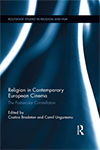- Author(s): Stella Ramage
- When: 2015-02
- Where: Victoria University of Wellington
This thesis considers conflicting representational strategies used by Christian missionaries in displaying Melanesian people to white audiences in the West with particular reference to films made during the period of colonial modernity between 1917 and 1935. Most scholarly work on Christian mission in the Pacific has focussed on the nineteenth century and on the effect of Christianisation on indigenous populations, rather than on the effect of mission propaganda on Western communities. This thesis repositions mission propaganda as an important alternative source of visual imagery of the Melanesian ‘Other’ available to white popular audiences. Within a broader commercial market that commodified Western notions of Melanesian ‘savagery’ via illustrated travelogue magazines and commercial multi-media shows, missionaries trod an uneasy knife-edge in how they transmitted indigenous imagery and mediated cultural difference for white consumers. Five case-studies consider missionary propaganda from four Christian denominations in disparate parts of Melanesia. They reveal a temporal trajectory in the conflicted but symbiotic relationship between, on one hand, missionary organisations interested in propagandising their work and, on the other, travelogue-adventurers operating with commercial motives. This trajectory follows missionaries as they move from facilitation of travelogue-adventurers, through passive commissioning of their services, then active collaboration, and finally to autonomous film-making in their own right. I consider how white missionaries played a pivotal role in both enabling and subverting the dominance of the prevailing commercial paradigm of the period: that Melanesians are by nature and definition ‘savages’ and ‘head-hunters’ residing in a thrilling, timeless, virtual place called ‘Cannibal-Land.’ These contradictory impulses, I contend, destabilised both Christian and ‘Cannibal-land’ stereotypes. This destabilising effect was not restricted to film, but I suggest that it was amplified by the use of the quintessentially modern medium of moving images. I argue that film – particularly film made by missionaries – posed an implicit challenge to the essentially literary trope of ‘Canniballand’. Moving images offered a more unruly medium within and around which indigenous Melanesians of the colonial era could sometimes display what I term a radical visibility that escaped and transcended both types of Western stereotype.







